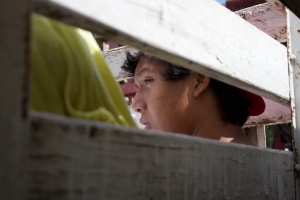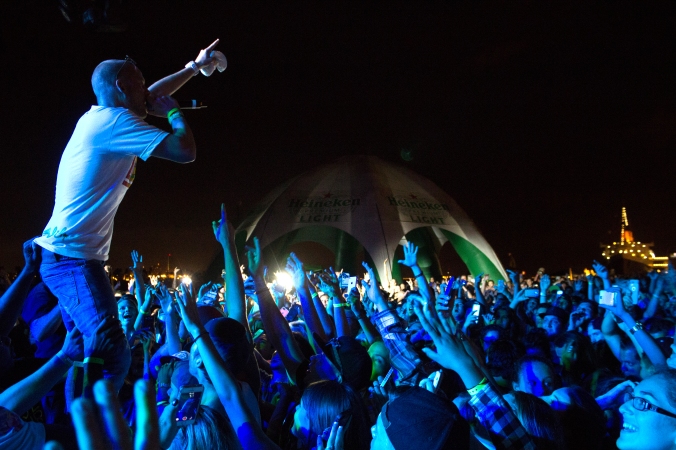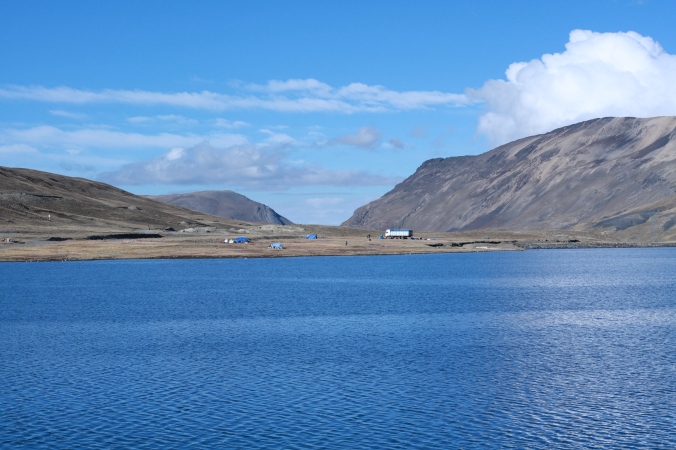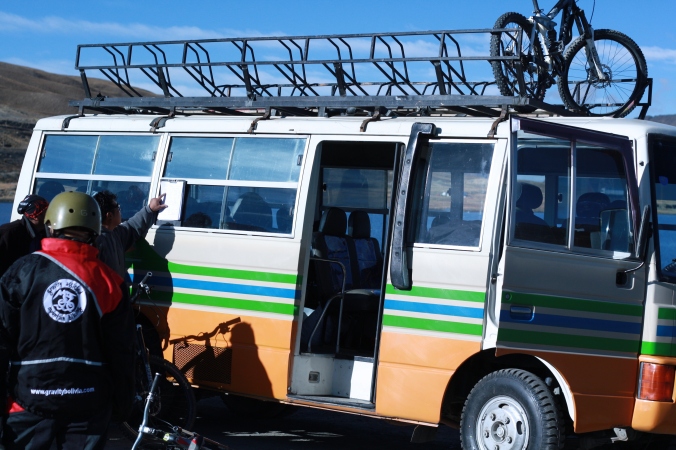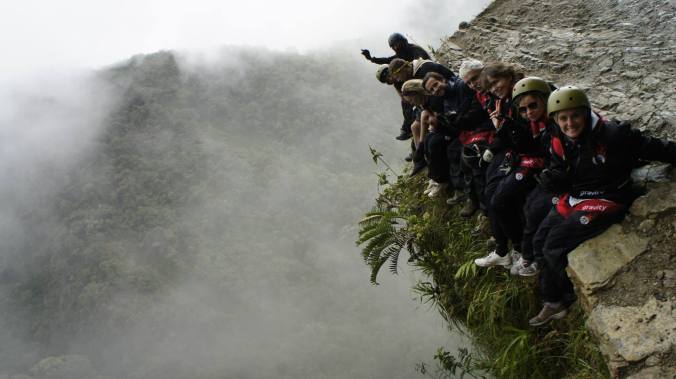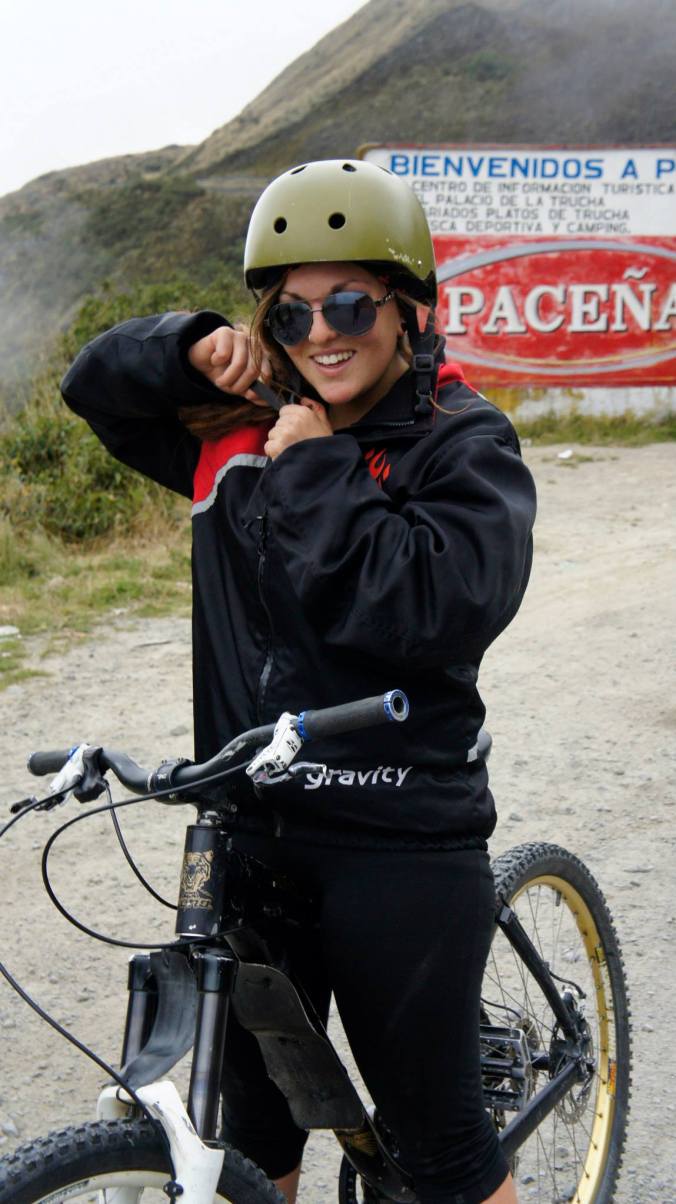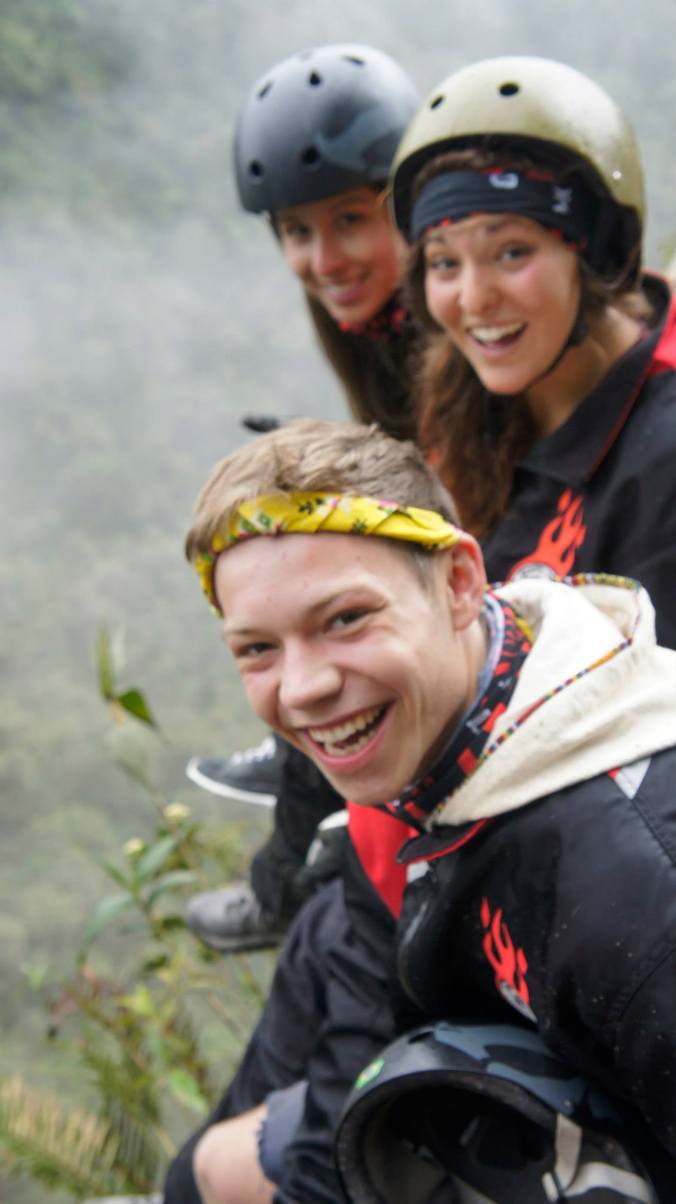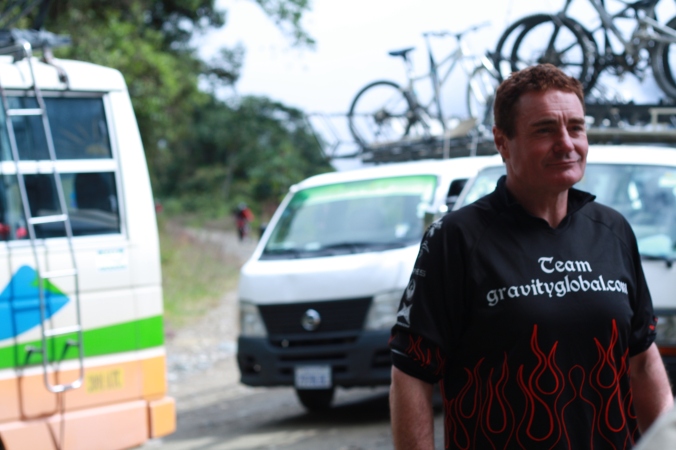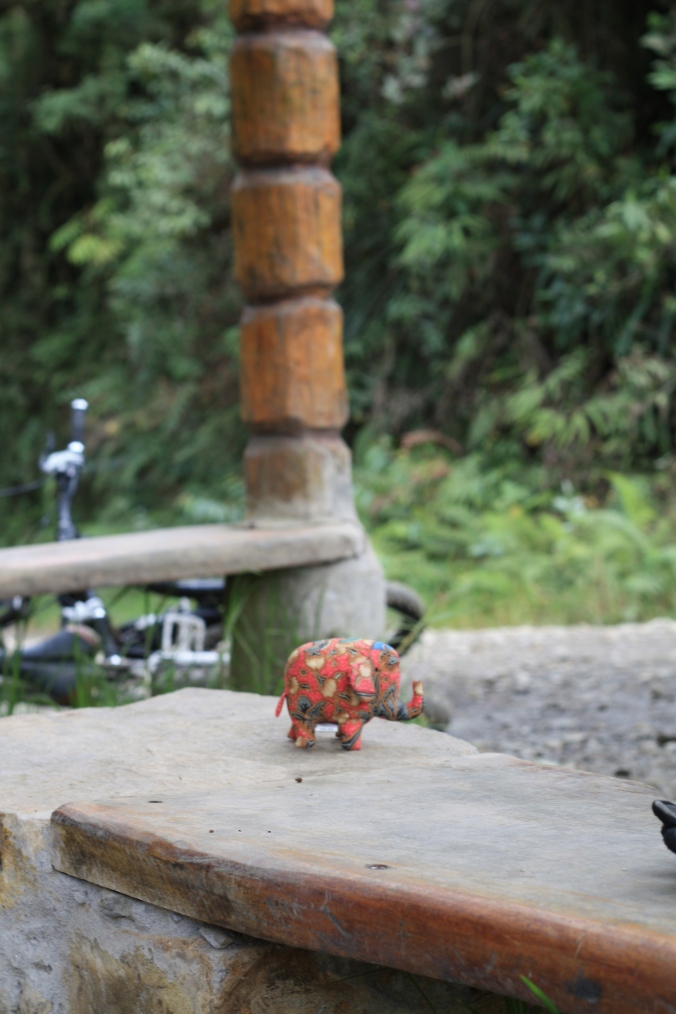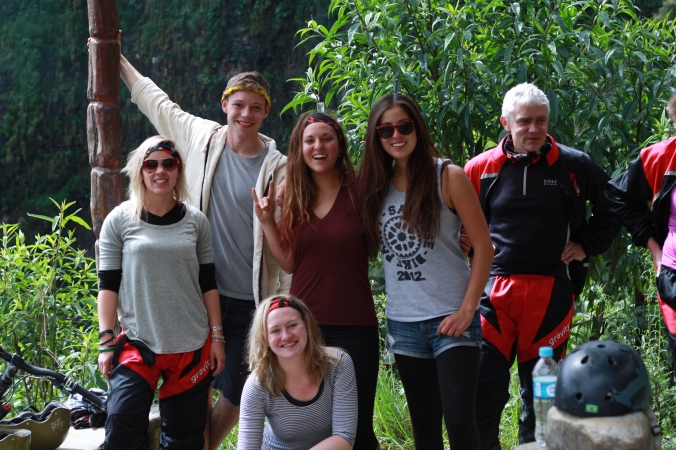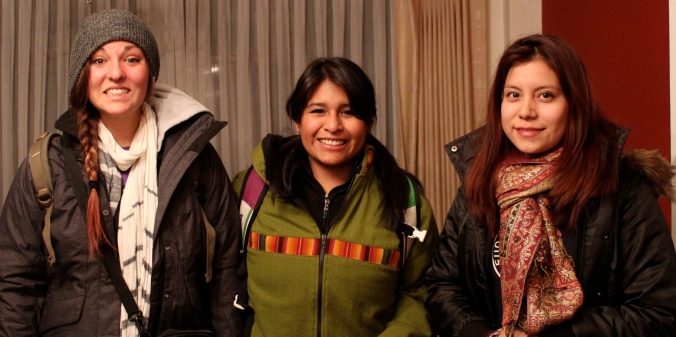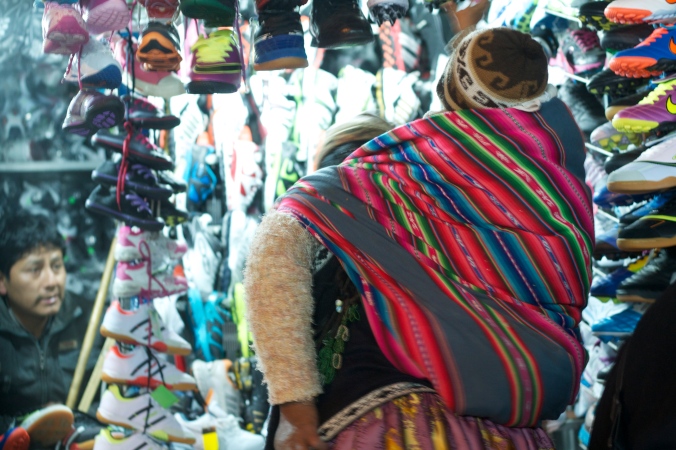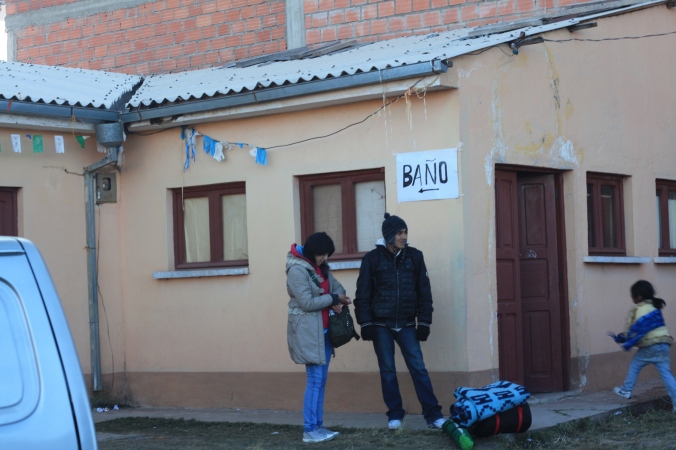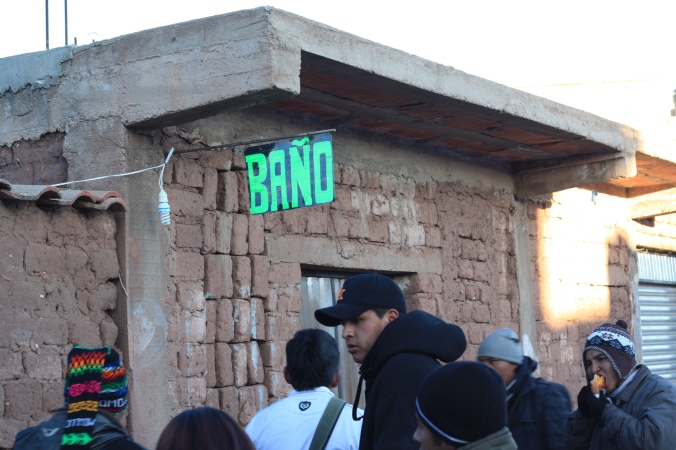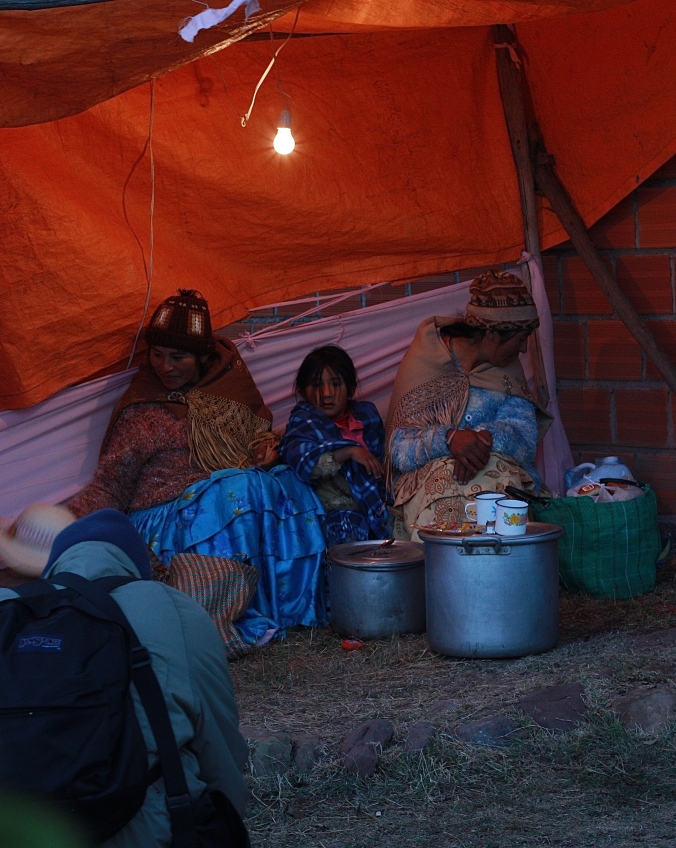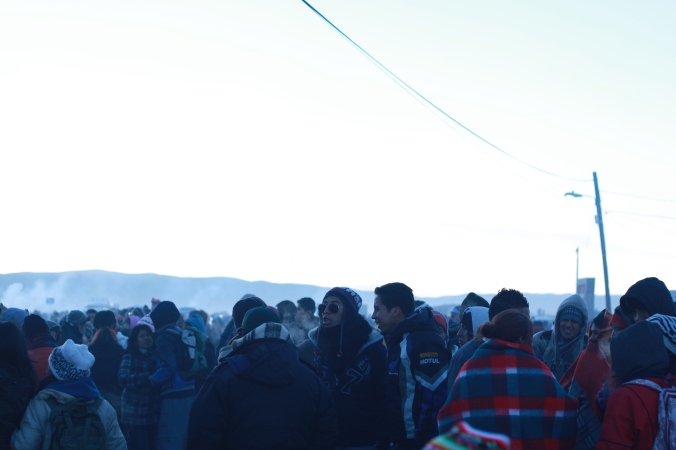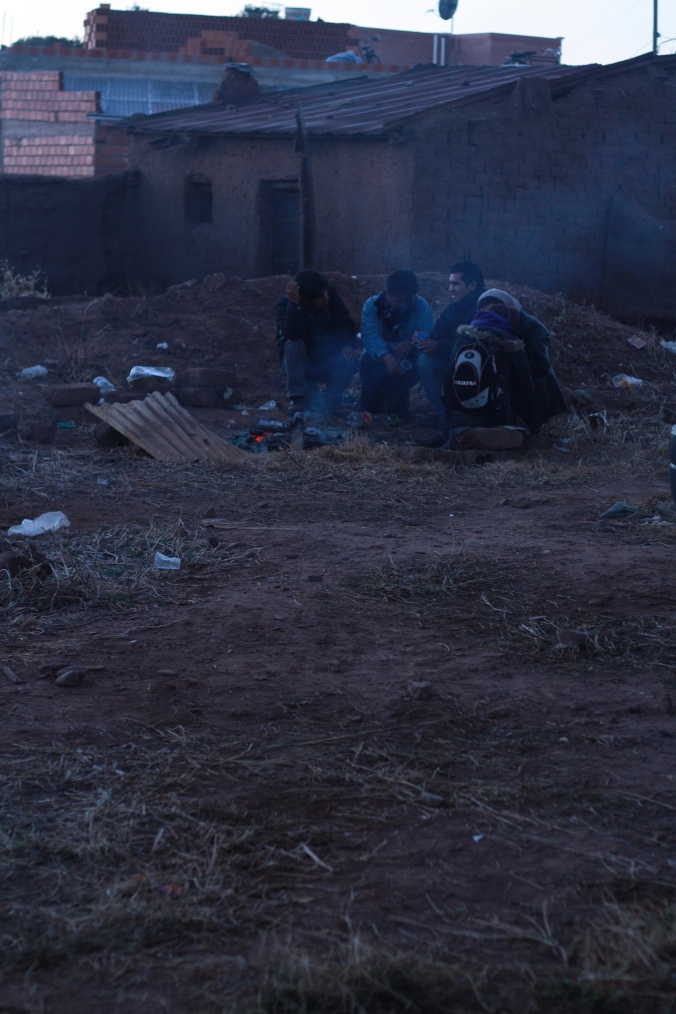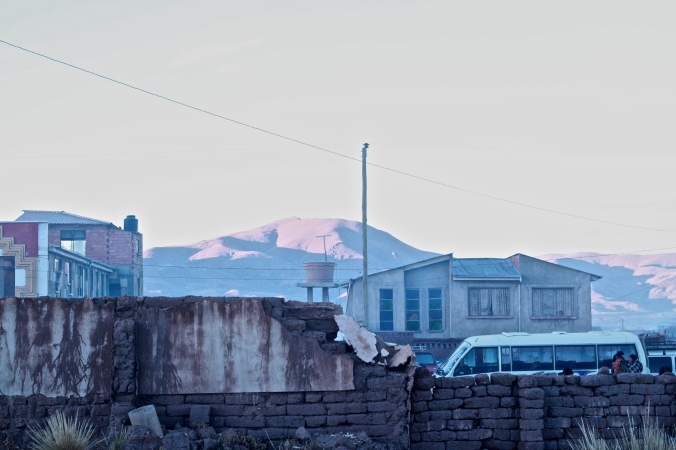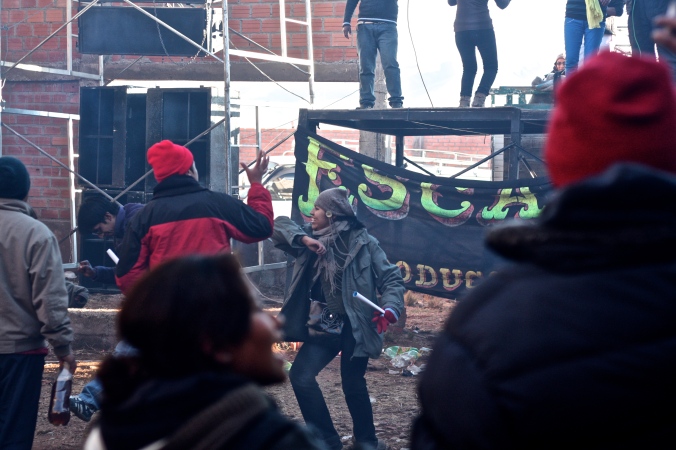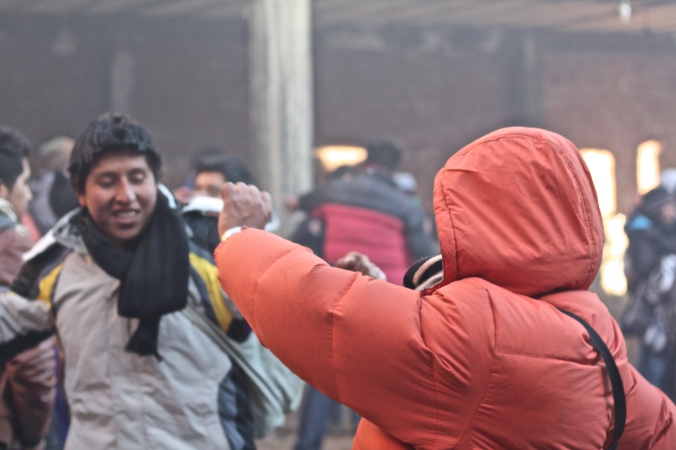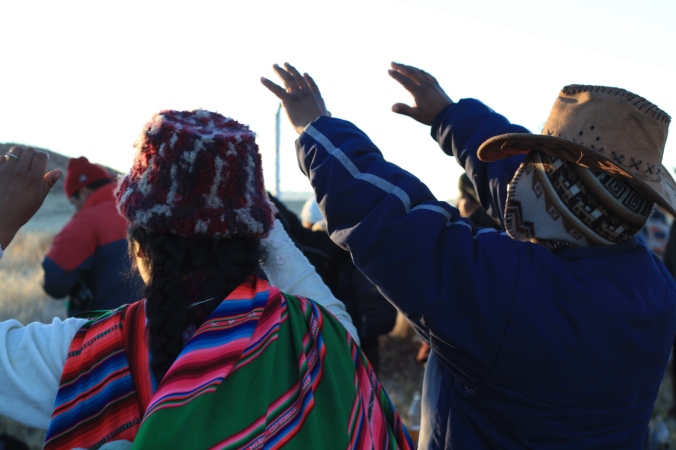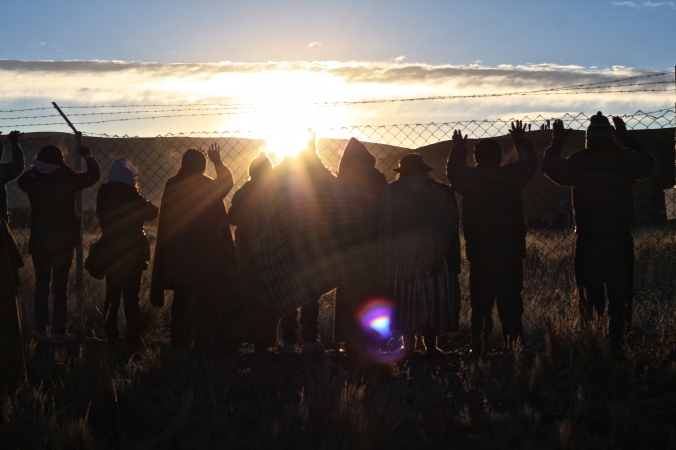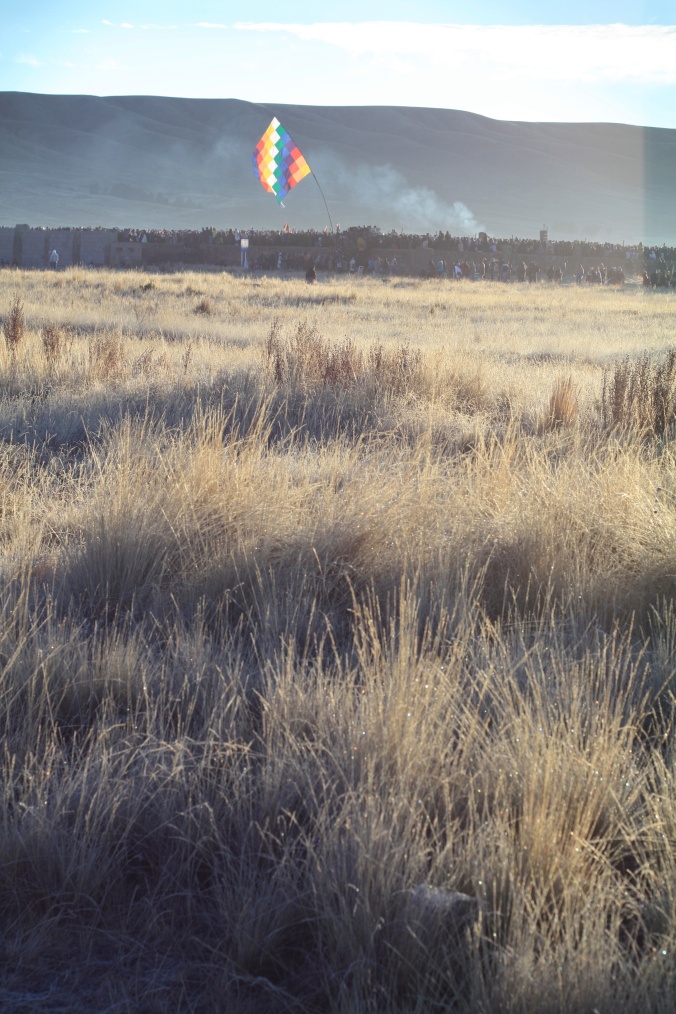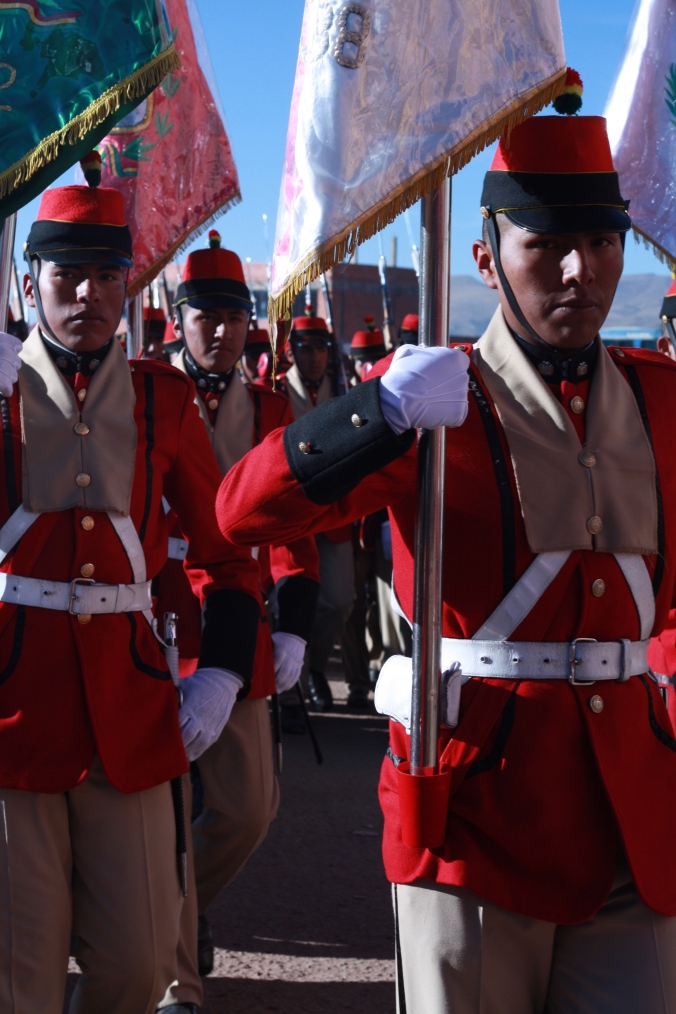A rainbow of spectators fidgets on the white leather couches as they wait for the drag queens to take the stage. A faint spotlight swirls on the cement floor and around the unbecoming wood pillars that hold up the small club on Ocean Blvd.
Get Stoked.
The world is a beautiful place to be.
They call me “Gringa Yucateca”
First it was the heat.
I knew there were some adjustments to be made. I was packed like I was very poorly packed for a backpacking trip, one pack with my computer, lenses and other survival gear that I wouldn’t end up needing, another with too much clothing.
Visions of Long Beach’s Shoreline Jam
The love of derby needs no rink
The original article, “Moving past bad blood, ladies of the Long Beach derby scene unite in the name of skates,” was published in the Long Beach Post with several significant errors. Below is a revised version.
The raddest day of my life.
It’s been almost two weeks since I biked the death road, and the adrenaline rush has worn off a bit. I just finished my articles, so I finally have time to rave about the funnest day ever. It’s pretty difficult to choose “the raddest day of your life”; it’s almost like choosing your favorite brother. But at the same time, it’s like rating all the movies you’ve seen a 4/5, never giving one a 5/5 due to anticipation for a film that’s just a little better than the rest. Therefore, I sucked it up and chose that Sunday.
We were packing to travel from one climate extreme to the next: Dry, arid high elevation to air so warm and moist it was like a giant sauna nestled in between mountains and trees.
We wore a couple layers and leggings with trainers or hiking boots, pretty standard. We packed extra clothes for the end to make the finish even more satisfying.
We awoke at 6, the earliest I had been up yet in Bolivia while at home this is generally my standard. It’s nice to experience La Pax in the morning, where newspapers replace piles of fruit and the sun reflects softly off of the askew cobblestones that make up the streets. Walking around a city in hiking boots makes you feel like a legitimate backpacker, while we were really just a few miles from ‘home.’ We met at a popular coffee shop and awaited the group and guides.
We couldn’t drink too much coffee or else we would have to go in the one of the various holes in the ground along the road up to the top of the road.
The bus was full of great people. Four being my friends and the others being exceptionally cool, I knew this was going to be a fantastic day. We told embarrassing stories and marveled at the quickly morphing sights as the bus rumbled through.
We stopped in the snow, yet I was too excited to be cold. The bus was parked by a lake that one of the guides (the new guy) said was El Lago Titicaca, but I found this hard to believe as it was simply a large pond, which didn’t stretch beyond my view as Titicaca should. We put on our Gravity baclavas to keep our faces warm, and some put on the badass (yet still chunky) jumpsuits. We got on our bikes, mine was named bart simpson, I called him bartholemeu. This was the first time I’ve ridden a mountain bike, and I loved it. Made me want to buy it, despite the starting price of $4000.
We went over the rules, me with a stupid grin on my face the entire time. Then one of the guides pulled out a small bottle of clear liquid, advising us to pour some on the ground, some on our tire, and then take a swig, because it’s really strong. We were giving tribute to Pachamama, mother earth of the Andes, to help keep us safe before we began the 60 km ride. I naturally took a much-too-large swig, leaving my stomach more fluttery than before.
We took off, immediately downhill on a windy highway. The first 25 km was pavement. I found myself in the front three for the entirety of this segment. You could say that I have a need for speed. hahah.
Everything was perfect, the bounciness and speed of the bike hurtling through scenery that was almost unreal. We punctured clouds and traveled from snowy surroundings, to mist, to a foggy jungle.
Each time we stopped I was more and more ecstatic about what I was able to experience.
We passed through a drug checkpoint, where we had to pay to pass. We passed buses going the speed limit, signs saying 30 km/hr.
We finally reached the entrance to the actual death road, a narrow, dirt road that wound above the depths of dense jungle.
At first the ride was a little sketchy, rocks were imbedded in the road such that I had to grip the handlebars, so hard that I knew my forearms were to be sore. The road became more and more narrow and continued to slope downhill, through mist that turned into waterfalls, bringing a sweet mixture of fear and excitement. Should I brake, should I pedal faster? The adrenaline rush was great, my heart was beating but I was so sharply focused that my reaction time was quicker, a feeling like no drug.
Yeah, I know that Gravity Mountain biking takes out about 60 people daily and this is nothing special, but I was still stoked on it.
We stopped at multiple landmarks along the way and the guides told us horror stories about back-breakingly sharp curves and riders following butterflies off cliffs. We took breaks on the side of the road and shed layers as we descended down deeper into the rainforest, away from the cold for which I traded my Californian summer.
Houses began to appear in clusters, hanging over the edge of cliffs or nestled in between the trees to our right. Children and families walked along the sides of the road, barely glancing twice at us adrenaline-seeking tourists ripping through their neighborhoods. The guides told us not to give the schoolchildren high-fives as we rode past, as they are known to grab your hand despite your downhill acceleration. Yikes.
I brought my malaria pills with me as I was told that any region below 7000 feet is mosquito-territory and therefore a malarial zone, but the agency assured me that I wouldn’t need them. When bites appeared on my chest and legs, I freaked out a little to myself, unsure how many bites and therefore how many sicknesses I would be prone to, due to the fact that a few had entered my agape mouth as I was focused on my human-generated roller-coaster ride.
We stopped for oranges next to a cluster of houses, adorable dogs and chickens walking along the sides of the roads. A man sat outside on a bench, his single leg supporting him, his hand draped over a handmade cane. A sign next to his implored passersby to donate anything possible, as he had been bitten by a rattlesnake and had to amputate his leg, leaving him unable to provide for his family. A few of us gathered change and gave him all we could. One of the two guides told us that within the month, he is planning to bike up and down the death road (it’s not that fun to bike back up) and collect funds for a prosthetic leg for the man.
This is why I love travelling. I’ve met the most beautiful people on this trip. From what I’ve found, the world’s most conscientious, appreciative people are drawn from their houses, countries and comfort zones to these areas of the world. They are nature appreciators, people watchers, and scholars. Marcus, this particular guide, expressed his passion and love for latin america as an avid cyclist. The next day, when we went to the Gravity house to pick up T-shirts and photo CDs, we noticed that quotes from passionate bikers were scattered along the walls. The most memorable read:
“Everytime I see an adult on a bicycle, I no longer despair for the future of the human race.” -H.G. Wells
Radiant was the energy shared between this group of active, educated people. Maybe it was just the drugging affect of the adrenaline, but yeah, I was obviously stoked.
When we got to the bottom, we threw up our jackets and drank some beers that had been waiting for us at a random bar, absolutely filthy and sweaty, laughing and relaxing, breathing in the dense air.
We took the bus a short distance to another attraction, of a name that escapes me, but was cut off from the road by a strong river in which we swam-or rather waded- for awhile before showering in a bathhouse surrounded by a nature reserve. After putting on shorts and flip flops for the first time in what felt like forever, we ate a mediocre-yet obviously delicious at the time- pasta dinner, looking at pictures from the day in which we looked a lot less cool than we felt.
And so went my first official adrenaline rush in Bolivia. Hopefully, there are more to come.
Tiwanaku: My 12 hours as a Bolivian
The Aymara new year is celebrated on the winter solstice every year in Bolivia. Indigenous and tourists alike travel to a number of popular destinations to celebrate the festival, two of the most popular being Salar de Uyuni and Tiwanaku. Indigenous Aymara President Evo Morales has declared the Aymara New Year a national holiday, a subject of debate yet a popular festival among Aymara native and non-natives alike. During the ritual, the people worship Pachamama (mother earth of the andes) and Inti (the father of the sun).
I was originally going to go to Salar de Uyuni on a bus for press with my friend Alexandra, as visiting the vast salt lakes would be the prime way to experience the Bolivian tradition. However, Tiwanaku was much closer, slightly less glacial, and my Spanish professor was going. She said that there would be plenty of dancing to distract from the cold, and live bands. This was about to be awesome. So we stacked on layers until we were nearly immobile and packed blankets and sleeping bags. With huge bodies and huge packs, we trudged up the street with limited peripheral vision and hailed the cab that we would be sitting in for the next hour.
We took the cab to the most dangerous part of La Paz, El Alto to meet with people that seemingly existed. El Alto is what a few of the girls called “real Bolivia,” which I prefer not to believe, as it is much more impoverished than many other parts. Tents fashioned from wood and tarp lined the road, and as the wind blew the makeshift doors open, we realized that these were homes, lit by a single lightbulb. Since I have complained much less about the draft in our Sopocachi house.
Our housekeeper, Virgenia, has a sister named Fabiola that was going with friends that owned their own minibus. This was more fortunate that we thought, because as three American girls in a non-tourist environment, we would have been hopeless.
It took ages to navigate to where we would meet Fabiola, as El Alto is an everlasting swap meet. [photo] We sat in the taxi watching bundled Cholitas with babies bouncing in the sacks on their backs, bartering and fingering goods from shoes to Cholita skirts.
We stopped at the corner where we were to meet her, and the street was swarming with locals. Bundled up and barely mobile, we kept our backs to the wall of a building to avoid being robbed in what is known as pick-pocket central. We barely remembered what she looked like, so we were shouting her name at random people who must have been wondering what we were doing there.
She finally found us, immediately telling us to watch our backs as we weaved through the masses of late-night consumers. We finally came upon a privately owned mini bus parked on a dark street.
We sat in the back of the bus and waited to begin the journey, still excited but slightly irked. While we were parked, multiple people poked their heads in, asking if we wanted to buy coffee. Cholitas clawed at the sides of the bus, trying to get home, not knowing that we were heading towards the middle of nowhere, far from their homes. The boys began filling the bus with strangers, not quite as bundled as us, whom Maricielo, who speaks fluent spanish, later told us that they were poking fun at us.
The traffic was horrendous, but we finally got moving. The farther out of the city we traveled, the deeper into the darkness we plunged, and the more unsure we became. We came upon bumpy road, rumbling on rocks and dirt. We all had to use the restroom, which to privileged tourists is like a death sentence, because no matter where we passed during the journey, it was either desert or holes in the ground.
We finally arrived in the dimly lit town of Tiwanaku, the van spreading the people like a red sea, causing them to peer into our windows, their breath visible.
Tiwanaku, like many areas of La Paz, looked like a night market more than anything. Women selling clothing, food and alcohol stood in front of the graffiti-covered walls and next to piles of rubble. Lovely restaurants and hostels drew a sharp contrast with dilapidated buildings and makeshift signs. We laughed uncomfortably as we saw the sign for the bathroom we would be using, propped in a dark alley, and stopped laughing completely when we entered.
We needed to sit somewhere warm, and we were hungry, so we slowly made our way through the thick towards one of the many “cafes.” This one was run by two Cholitas who made sandwiches out of bologna and hamburger buns, coffee and tea, backed by shelves full of coca cola. I discovered here that the Cholitas are much more approachable and conversational that they appear. One was telling me about the “jovenes borrachos (drunk kids)” who passed out in front of her cafe the previous year. Conversations like these are what drives me to learn to speak spanish fluently, as well as gain some ground on local dialects and slang. These women are quite charming.
It was freezing, and although windless, the temperature bit at us through our thin gloves, weaseled it’s way through our many layers. “Abrigado” and “prendas” were words I heard often through the bitter night, meaning “bundled up” and “layers”.
Turned out that there were no bands, no dancing, just a bunch of people using their vodka blankets to stay warm. Apparently some borrachos from the past year caught a tree on fire and caused damage while raging to a live band, and for this reason the fun had been revoked. But the people had other means of having fun. We walked through an alleyway where women made hot alcoholic drinks and people sat in the many tents laughing and drinking.
We came upon an open area with some dry brush, and the guys decided to start a fire for warmth. What would be highly illegal in the United States apparently is no matter for concern in this ancient town in Bolivia, and although police were crouching at every corner, they had other concerns (about what, it beats me). The fire was more smoke than anything, tainting our clothing and convincing us that it was time to attempt to sleep.
Once again I would like to express gratitude towards Fabiola and her friends, as we would have had to sleep outside-or not at all- if we didn’t tag along with them.
Nevertheless, we couldn’t sleep; still wearing all of our layers and wrapped forebodingly in blankets and sleeping bags. People were shouting outside, and when I heard drums around 3:30 am, I knew we needed to make the most out of this situation that we had unknowingly plunged ourselves into.
I woke up Catey, who said her leg was basically frozen, and we left the bus to keep our legs busy. Thank goodness we did, because the next couple hours were the snippets of experiences that made Tiwanaku worthwhile- or at least memorable.
We sat in a “cafe” and asked for tea; the woman promptly sat us down and proceeded to ladle a hot amber liquid into a reused alcohol bottle, handing it to me with plastic cups. It smelled of rum. In my terrible spanish I told her that “No quiero alcohol, solamente te..” to which she replied that it wasn’t alcoholic, but rather good for the cold. Potata-Potato, right?
We drank a few cups and left, for the first time not wanting to turn this experience into more of a party. We went to the neighboring cafe and asked a couple locals if we could share a table with them, beginning a great conversation, despite the slight language barrier. We ordered coffees and egg sandwiches which, at the moment, were the best thing we had ever eaten. The men, drunk, were great fun to talk to and very tolerant of our spanish. They told us about the tradition of tribute to Pachamama, through which the Aymara people will always pour a bit of their food or drink onto the earth before enjoying it themselves. He said that even the poorest people will do so, more so than the wealthy with their pricey libations.
We parted ways and were drawn to a fire like mosquitos, where a group of borrachos fell in love with us immediately. Whilst a swaying Bolivian was whispering sweet nothings into Catey’s ear, I spoke with a guy with a braid, his left cheek bulging with chewed coca leaves. He asked questions about traditions like these in the United States. After telling him that we’re journalists with the Bolivian express, he begged me to show the beauty of the tradition, not the borrachera. I assured him that we were simply there to learn about the tradition, and we’rent reporting on it, because in reality, the traditional culture was not as apparent this year.
At this point, light was beginning to appear along the horizon so we returned to the minibus to retrieve the others, who of course had been worried about us. We grabbed our cameras and followed the masses in their pilgrimage towards the Ritual of receiving the sun. The light revealed people laughing and stumbling, seated confusedly against walls. People were passed out in distant fields, and some were stumbling towards the sun, yet not getting anywhere. The colors of traditional dress were brightened by the lightened sky and Cholita women were still murmuring their sales pitches to passersby.
A makeshift nightclub housed in a roofless building was bumping with the beats of a DJ and drunk people rambled on stage, dancing to the tunes. The people that still had their wits danced an indigenous dance around broken bottles and the remnants of fires. It is now one of my objectives to learn this dance.
When we reached the gate through which people passed to attend the ritual, we were informed that locals costed 10 Bolivianos to enter, while tourists costed 80B. We turned around and walked as close to the fence as possible, which sufficed perfectly. Locals stood with their hands to the sun as it rose over the curve of the earthen plains. This was the beginning of the new year, and the Aymara people welcomed it by grasping at the sun that dawned upon the year of 2013.
At the same time, I realized why the people stay all night to await the fleeting moments of sunrise. By enduring the freezing nights, the people were able to truly appreciate the redeeming warmth of the sun as it blanketed their stiff, open hands.
The Aymara flag (or the flag of the plurinational state of Bolivia) was raised beyond the chainlink fence where the ritual occurred, and the Aymara and Spanish-spoken ritual echoed over the field.
We walked and relished the warmth of the sun after leaving the ritual. We sat in the van, and although delayed with a dead battery, we were just happy to be warm.
Coming soon: Hats that read “I froze my ass of and survived the Aymara New Year 2013, Tiwanaku”
The not-so gentle green giant.
“Big agriculture” is what they call it these days, because after all, bigger is better in America.
The FDA and the White House are in cahoots with Monsanto, a multinational agricultural corporation that controls nearly 90 percent of all genetically engineered seeds, from which nearly 90 percent of all corn, soybeans and cotton are grown. Genetic engineering of food represents one of the most rapid adoptions of agricultural technology in history.
Look at the ingredients on whatever you eat next. Chance is, it contains soybean oil, high fructose corn syrup, or any of a plethora of soybean or corn products.
Europe is over it, however. Monsanto, the most powerful pusher of GMOs on the planet, is heavily opposed in the EU, mainly in France and Germany. The protests are not as much about how genetically modified foods affect health-which is still debatable- but rather how mass production exhausts the environment.
The EU, which takes the process rather than product-oriented perspective on GM, has been labeling food containing food containing as little as 1 percent GMO for over a decade.
Just over a week ago, over two million people in 52 countries marched the streets in protest of Monsanto, which is working just as hard to quell controversy.
Monsanto has had a history of marketing harmful products, and there’s cause for concern when the soybean engineer is also a leading producer of herbicide and former manufacturer of DDT, PCBs and Agent Orange.
The government has always been a driving force behind big agriculture, seeking to promote the economic potential of GMO rather than focusing on environmental impact. In 1984, the White House granted the Cabinet Council on Economic Affairs, rather than the EPA, responsibility for regulating biotechnology. As a result, the EPA was only in charge of regulating agricultural pesticides, while the environment should be protected from much more.
Finally, in March, Congress passed the “Monsanto protection act”, which took regulatory power out of lawmaker’s hands, turning Monsanto into a lawmaker itself. Europe saw this as a red flag.
Farmers are looking less at their almanacs and more to banks and technology firms with which they are contracted; no longer are farmers independent to produce what the land and climate allows.
Restrictions result in decreased biodiversity, so the supply of unmodified organic goods is so low in comparison to GMOs that prices remain high, diverting consumers from buying organic.
While GM crops over accommodate the ever-growing population and our iconic American appetites, mass production and consumption overwhelms the ecosystem. Like the garbage landfill we fill daily, GM crops harm the land and facilitate conglomerate success.
For example, specific regions and seasons naturally yield different kinds of crops. When the land is drugged and contaminated with additive-filled plants to mass-produce mostly corn and soybeans year round, the biodiversity of the land is compromised.
Compared to the EU, our heavily conglomerated food industry is flawed. Contracted farmers buy genetically modified products that are enhanced to resist pests, yield more successfully and bring in more revenue.
It is under corporate control that small farmers that don’t comply with monopolies such as Monsanto are shut down.
It is for this mass production that cattle are injected with growth hormone, drowned in antibiotics, and crammed into despicable conditions that, if experienced first-hand, could convert half the nation to vegan.
The sad part is there’s no escaping it. One can choose tofu over a steak, but the tofu is made with soybeans that are overtaking the land that was once biologically diverse.
Stop feeding the corporate giant, he’s destroying our environment.
Nothing-to-do
So you’re here because you have nothing to do, eh?
Master Linji, in his Buddhist teachings, states that nothing-to-do is a result of enlightenment. In our privileged society we often complain of having nothing-to-do, which in reality should be a privilege of those who have already become enlightened.
Today’s idea of “nothing-to-do” is accompanied by dissatisfaction, frustration and desperation. From this results the booming entertainment industry, overconsumption (of both products and food) and binge habits. Why is it so difficult to walk outside and think? Why can we no longer be alone? Linji compares the unlightened mental state to “meatball mind” in which humans have minds clogged with silly preoccupations and dependence on the material.
I’ve discovered that trying too hard to become “enlightened” will result in a vacuuming of time. These days, there is too much to do to fill our time, resulting in frustration and ambivalence, lack of action. Everything is disposable, most people have access to all things. Craft has been devalued.
Stress over how to properly fill free time will only result in ambivalence and pensive staring.
“What should we do today? Well, we no longer have time to do that. Let’s just chill.”
I even have trouble figuring out what movie I want to watch on netflix, how to get the most out of my two hours of leisure. Sometimes, I get frustrated with my wasting of time. I should have filled that space between class and work with some art, maybe reading.
Time management is often more difficult for the person who wants to do everything at once, the hopeful and ambitious. Therefore, we say have nothing to do, while so many concepts and ideas are left unexplored. We are fearful of unclear destination. This is a result of our insecurity as a human race.
By nature, humans in this consumerist society are socialized to be disgustingly dependent and insecure. We are taught that it is rude to stare, to trust no one, that we should not talk to unfamiliar people (to whom we give the name “strangers”).
Our days are filled with senseless analyses in the mirror, twiddling of thumbs, daydreamers’ gazes and actionless aspirations. Our lists grow longer as our sporadic interests change, passing each occasion away in fantasies. We collect books we never read, that share shelves with newspaper clippings and half-finished sketches. Material accumulation is easier than careful consolidation. Passions are disposable as hobbies, nicknames.
We purchase and consume with the hope that it will bring us happiness and fulfill this void we call nothing-to-do, but consuming only widens it.
There is always time to become enlightened.
Wake up a little earlier.
Give less shits about your appearance.
Leave your phone at home, stay away from your computer.
Najarjuna, one of the most important Buddhist philosophers of historical buddhism, held that “nothing exists, nothing inexists, nothing exists and inexists, and nothing does not exist and inexists.” While this is a concept that took me a good while to grasp, I have come to the conclusion that material means nothing, and dependence on any of the sense objects is fruitless. The only real thing lies in the middle of all of these concepts.
Solution: We must pursue truth with as little on our backs as possible: minimize worries, material and preconceived notions. Take things as they come, enjoy the present moment.
That’s my rant for the day.
Complimentary vs. Conventional
Antibiotic development has been stagnant since 1987, and bacteria are constantly getting stronger, fighting back against these now antiquated medicines.
According to a March 20th article by the Washington Times, businesses resist making new antibiotics because the development is expensive, resulting in drug-resistant pathogens, known today as “superbugs”.
According to the CDC, these “superbugs” kill 99,000 Americans a year.
The fact that the pills on which people in many developed countries depend are becoming ineffective illuminates the possibility of alternative, or “complimentary” medicines, including homeopathy, a controversial method that has been practiced for over 200 years in India and the UK, far too long to be dismissed as “quackery.”
“Bacteria are almost always opportunistic,” Dr. Mark DeDubovay, a certified naturopath of Long Beach’s Advanced Wellness Center, said.” They are like the lion on the Sarangheti, they pick the weak.”
According to Heidi Burkey, Coordinator of the Health Resource Center at CSULB, antibiotics do not always kill bacteria, resulting in the “natural selection” of the stronger germs and perpetuating illness.
Sitting at a desk so clean that it mirrored her image, behind her, a sign read, “Heatlh educators prescribe wisdom”.
Homeopathy is based upon the use of substances that cause an illness in a healthy person, but are theorized to cure that same illness in a sick person, according to Dr. DeDuboway. These remedies are administered after being diluted repeatedly in alcohol or water.
Samuel Hahnemann, a German physician, named the practice and believed that while taking large doses of a substance would only aggravate illness, if heavily diluted, it works somewhat like a vaccination.
Homeopathic remedies, although don’t work as quickly as antibiotics that sick westerners gobble like cough drops, are said to help strengthen the immune system because of their vaccine-like purpose, according to DeDubovay.
Homeopathy is commonly explained by the concept of “Water Memory” which was conceived by Jacques Benveniste, a French immunologist. In Benveniste’s theory, the configuration of molecules water is biologically active. In other words, even when a certain element in nature is drowned by dilution to its ends; it holds memory of the past solute.
Homeopaths also say that the higher the dilution, the higher the potency. This is what truly irks those western doctors and mainstream scientists.
However, not all homeopaths believe that high dilution is effective. Those doctors who favor lower dilutions gravitate towards the pathology argument and conventional practice, while homeopaths that use higher dilutions emphasize spiritual forces of a disease.
“It’s energetic medicine, so people who don’t understand it are purely in the physical medicine realm,” Dr. Mark DeDubovay, a Certified Traditional Naturopath at Long Beach’s Advanced Wellness center, said. “They [also] don’t understand acupuncture or mind-body healing.”
According to Jay Shelton in his book Homeopathy: How it Really Works, psychological and spiritual effects most commonly lead to the improved health of the homeopathic consumer. These include the Placebo effect, natural healing of the body and the therapeutic effect of the consultation itself.
While he says explaining homeopathy to a non-believer is difficult, Dr. DeDubovay does not insist that homeopathy is the solution, but rather says that avoiding unneeded antibiotics and leading a balanced lifestyle is the key to good health.
“The concern is the indiscriminant use of antibiotic therapy,” Dr. DeDubovay said.
Sick people in both the US and UK have upped the dose, according to a 2010 study by Medscape.
“ I think its necessary to still take [antibiotics] because obviously my body’s not taking care of itself at the moment,” Dina Bandziulis, a sophomore Graphic Design student, said.
Bandziulis said that she doesn’t trust the obscure realm that is natural medicine because she already knows that antibiotics work.
“Doctors and nurses are not willing to be specific,” Dr. DeDubovay said. [The medicines they prescribe are designed to] kill everything and this doesn’t help the interest of the patient.”
Because of the disequilibrium of bacteria, or probiotic that results from taking antibiotics, Dr. Dedubovay said that obesity, weakened immunity and long-term damages ensue.
“It’s a constant struggle to maintain bacteria balance,” he said.
According to DeDubovay, this balance can be regained by reverting back to a natural diet, allowing ourselves to consume natural bacteria such as fermented food, and forming a symbiotic relationship with the surrounding flora that protects us from allergies and autoimmune reactions.
Burkey says that antibiotics often kill off good bacteria that defend our bodies from illness. However, ethical practice can prevent from detriments to health.
Burkey said that as a clinic, CSULB Student Health Services follows natural standards of practice and practitioners hesitate to prescribe unless the patient shows evidence of serious bacterial infection, despite their demands for a quick fix.
Burkey said that the pharmaceutical companies spend more money on marketing than research and development, resulting in antibiotics that can’t keep up with impervious bacteria and sick people that just don’t get it.
Studies have shown that antibiotic prescriptions decrease if doctors educate patients about the risks of antibiotic overuse, according to an article by the National Post.
“People aren’t educated that there is a long-term solution but they are given the impression that problems are chronic and they’ll have it for the rest of their life,” Dr. DeDubovay said. “People are lead to believe that it is only an external factor outside of the self.”
While many Western doctors see homeopathy as “quackery” and fraud, Burkey says that clinicians certified in both conventional and what “complimentary”-or natural- medicine provide the best counsel.
“Traditional medicine is like the mass unit where soldiers are taken to have wounds stabilized,” DeDubovay said, “then they have to go to rehab facility, which would be the natural or complimentary.”
Burkey criticized those who blatantly reject holistic medicine, stating that the wellness model, which takes into consideration mental, physical and social factors, is much more successful than the Western medical model.
Burkey said that the office visit time is indicative of the quality of health care received. While many busy conventional doctors see patients for as little as 2 minutes each, holistic doctors see their patients for at least half an hour to bolster doctor-patient bonds.
DeDubovay referred to a famous proverb to explain complimentary medicine:
“Give a man a fish, he will eat for a day; teach a man to fish, he will eat for a lifetime.”
Both Burkey and DeDubovay say that Western medicine should take a more holistic approach. Natural medicine may not use chemicals to slay symptoms widely and quickly, but it does bring energies back into balance and prolongs good health.
